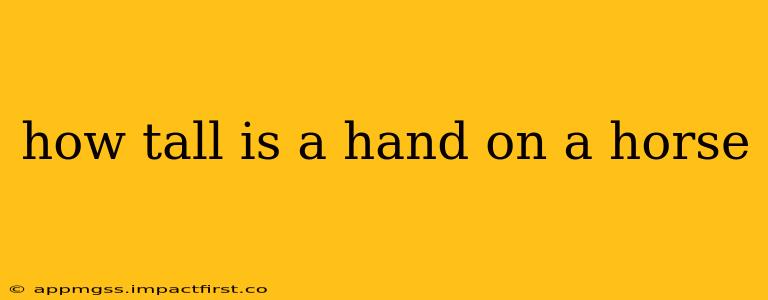How Tall is a Hand on a Horse?
Understanding horse height is crucial for anyone involved in equestrian activities, from riding to breeding. The standard measurement, however, isn't in feet or meters, but in "hands." This seemingly archaic unit continues to be the preferred method, causing confusion for many newcomers to the equestrian world. So, how tall is a hand on a horse?
A hand is exactly four inches (10.16 centimeters). Therefore, a horse measuring 16 hands high is 16 hands x 4 inches/hand = 64 inches tall, or approximately 5 feet 4 inches (162.56 cm). The measurement is taken from the highest point of the horse's withers (the ridge between the shoulder blades) to the ground. It's important to note that this is a vertical measurement, and the horse's overall length will be considerably greater.
How is a horse's height measured in hands?
Measuring a horse in hands requires precision. While experienced handlers can often give a good estimate by eye, accurate measurement involves using a special measuring stick—often with a hand scale clearly marked. The stick is placed vertically against the withers, and the height is then read off the scale. This ensures consistent and reliable readings, especially when comparing different horses.
What does a horse's height in hands tell us?
A horse's height in hands is often used to categorize the horse into different breeds or types. Some breeds are specifically bred for certain height ranges. For example, miniature horses are significantly smaller than draft horses. Knowing a horse's height can also impact decisions about tack and equipment choices. Larger horses may require different saddle sizes and bridle fittings than smaller ones.
What are the different height categories for horses?
While there aren't strict definitions across all breeds and disciplines, general height categories provide a helpful guide:
- Miniature Horses: Typically under 34 inches.
- Ponies: Generally under 58 inches (14.2 hands).
- Horses: Typically over 58 inches (14.2 hands).
These categories are not absolute and are often breed-specific. For example, a Shetland pony will be considered a pony, while a larger pony breed might be just under 14.2 hands but still designated as a pony.
Are there any other ways to measure a horse's height?
While hands are the standard, height can also be expressed in feet and inches or in centimeters and meters for clarity. However, the hand remains the primary unit within the equestrian world and is vital for communication and breed standards.
Why is the "hand" measurement still used?
The use of "hands" in measuring horses is a historical convention, dating back centuries. Its continued usage reflects the deeply rooted traditions within the equestrian community. While a metric equivalent exists, the familiarity and established practice of using hands persist.
By understanding the significance of "hands" as a unit of measurement, you can navigate the world of horse heights with greater confidence. Remember that a hand equals four inches—a seemingly small unit that makes a big difference in the equestrian world.
